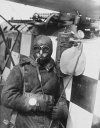100 years of the Royal Air Force's contribution to medicine: providing care in the air and delivering care by air
- PMID: 30072552
- PMCID: PMC6334056
- DOI: 10.7861/clinmedicine.18-4-297
100 years of the Royal Air Force's contribution to medicine: providing care in the air and delivering care by air
Abstract
The Royal Air Force (RAF) came into being during World War I as the world's first independent air force on the 1 April 1918, amalgamating elements of the Royal Flying Corps (RFC), itself established in 1912 and the Royal Naval Air Service which had formally separated from the Admiralty's administered Air Wing of the RFC in 1915. The RAF therefore celebrates its 100th anniversary in the same year that the Royal College of Physicians of London celebrates its 500th. This article will cover the contribution that military aviation has made to medicine since 1913 with the emphasis of three examples focusing on delivering care by air, providing care in the air and in developing systems for supporting aircrew or patients at the extremes of physiological stress.
Keywords: Royal Air Force; aeromedical evacuation; aviation Medicine; dialysis; oxygen systems.
© Royal College of Physicians 2018. All rights reserved.
Figures




References
-
- Dolev E. The first recorded aeromedical evacuation in the British Army – The true story. J R Army Med Corps. 1986;132:34–6. - PubMed
-
- Rankin RH. Sky Hospital. Flying and Popular Aviation. 2. XX1X. Chicago, USA: Ziff-Davis; 1941.
-
- Rood G. A brief history of flying clothing. Journal of Aeronautical History. 2014 Paper No 2014/01.
-
- Macmillan A. Development of breathing systems – contributions of flight research and flight trials. Royal Air Force Historical Society Journal. 2008;43:54–66.
Publication types
MeSH terms
LinkOut - more resources
Full Text Sources
Other Literature Sources
Medical
Research Materials
Miscellaneous

